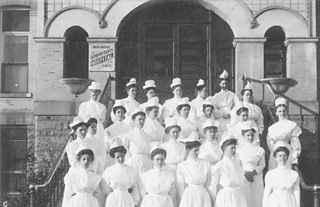
Maternity and Child Health Care |

One of the first graduating classes of nurses stands in front of the Dr. W. H. Groves Latter-day Saints Hospital (c. 1905). Courtesy Utah State Historical Society.
by Christine Croft Waters
Before professional doctors and nurses assumed primary responsibility for delivering health care, LDS women played a major role in providing maternity and child health care in their communities. Their efforts continued into the twentieth century with the establishment of maternity and children's hospitals and clinics under the sponsorship of the Relief Society and primary and with some women still serving as midwives in rural areas. The Relief Society also sponsored educational programs to prepare mothers for the delivery and care of infants and children. Concern for the health of mothers and children continues in Relief Society lessons today, and members are advised to seek the best medical care available. Specially trained Church missionaries also assist in programs to improve health care in developing countries.
At the time the Church was established (1830), the methods of many doctors were experimental and often harsh, and women usually did not call upon men for maternity care because it was thought unseemly. When available, midwives often assisted during childbirth. As the Church grew, leaders called and set apart women to serve as midwives. In Nauvoo in the 1840s, the Prophet Joseph Smith set apart three midwives. After the main body of the Church moved to the Salt Lake Valley, other women were called to serve as midwives both in Salt Lake City and in the outlying settlements. Because midwives were called by priesthood authority, they were accorded trust and respect similar to that given ecclesiastical leaders. They often dispensed herb treatments, passed on by experimentation and word of mouth, and sometimes administered health blessings.
Ward Relief Societies began coordinated health programs in the late 1860s after President Brigham Young assigned two of his plural wives, Eliza R. Snow and Zina D. H. Young, to promote health-care education among the Saints and to train midwives. In 1873 he asked each ward Relief Society to appoint three women to study nursing and midwifery, and a nursing school was opened for their training.
In the same year, President Young said that the time had come for women to study at medical schools in the East. At least six women responded, earning medical degrees in the 1870s. Most influential among these early doctors were Romania Pratt, Ellis Shipp, and Ellen Ferguson, who set up Utah's earliest professional training programs. Dr. Pratt wrote many articles on health. Dr. Shipp opened the School of Obstetrics and Nursing in Salt Lake City in 1878 and taught two six-month long courses each year, from which more than five hundred students eventually graduated. In 1888 she helped found Utah's first medical journal, the Salt Lake Sanitarian. Dr. Ferguson helped initiate plans for the Church-sponsored Deseret hospital, which opened in 1882 and shortly thereafter became the center for the School of Obstetrics and Nursing.
In 1899 the Salt Lake Stake organized the Relief Society Nursing School to provide nursing training especially for women who lived in rural communities and came to Salt Lake City for instruction. The school continued successfully until 1920.
By 1900 there were at least 34 female and 236 male doctors practicing medicine in Utah (Waters, pp. 108-111). The role of midwives began to diminish, but the Church's concern for maternity and child health care continued.
In 1911 the general presidency and general board of the Primary undertook the establishment of a hospital fund and the Endowment of two rooms for children in the LDS Hospital. Primary-sponsored hospital care for children continued, culminating in 1952 in the establishment of the Primary Children's Hospital, which was operated by the Church until 1975, when it was transferred to private ownership (see Hospitals).
In 1912, following the publication of a Utah State Board of Health report linking many infant deaths to inadequate prenatal and postnatal care (Morrell, p. 197), the Relief Society began an intensive program for educating mothers in health care for infants and children. Local Relief Societies sponsored day-long clinics. Stake Relief Societies in Cottonwood, Utah, and Snowflake, Arizona, established their own maternity hospitals. Clinics and health care for children remained high-priority items for Relief Societies until the mid-1930s, when the federal Social Security Act was passed, subsidizing educational programs, prenatal clinics, and immunization programs.
Today, Relief Society women are encouraged to seek appropriate professional medical care and to participate in nursing and first-aid classes. Relief Society manuals include chapters on health care and nursing. Among the full-time missionaries of the Church are a great many young women (approximately 270 in 1990) with health and teaching backgrounds who, in addition to fulfilling proselytizing responsibilities, are assigned to teach disease prevention, nutrition, and home health care to Church members in developing countries. Like the midwives of the early Church, they devote their time and talents to improving health care in the various communities where they have been called to serve.
(See Daily Living home page; Attitudes Toward Health, Medicine, and Fitness home page)
Bibliography
Divett, Robert T. Medicine and the Mormons. Bountiful, Utah, 1981.
Morrell, Joseph R. Utah's Health and You: A History of Utah's Public Health. Salt Lake City, 1956.
Waters, Christine Croft. "Pioneering Physicians in Utah, 1847-1900." Master's thesis, University of Utah, 1977.
Encyclopedia of Mormonism, Vol. 2, Maternity and Child Health Care
Copyright © 1992 by Macmillan Publishing Company
All About Mormons |